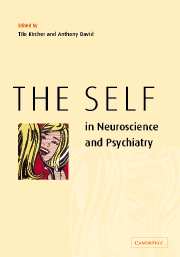Book contents
- Frontmatter
- Contents
- List of contributors
- Introduction: the self and neuroscience
- Part I Conceptual background
- Part II Cognitive and neurosciences
- 5 The multiplicity of consciousness and the emergence of the self
- 6 Asynchrony, implicational meaning and the experience of self in schizophrenia
- 7 Self-awareness, social intelligence and schizophrenia
- 8 The neural correlates of self-awareness and self-recognition
- 9 Autonoetic consciousness
- 10 The neural nature of the core SELF: implications for understanding schizophrenia
- Part III Disturbances of the self: the case of schizophrenia
- 11 Self and schizophrenia: a phenomenological perspective
- 12 Self-disturbance in schizophrenia: hyperreflexivity and diminished self-affection
- 13 The self-experience of schizophrenics
- 14 The paranoid self
- 15 Schizophrenia and the narrative self
- 16 Self-narrative in schizophrenia
- 17 Schizophrenia as disturbance of the self-construct
- 18 Action recognition in normal and schizophrenic subjects
- 19 Disorders of self-monitoring and the symptoms of schizophrenia
- 20 Hearing voices or hearing the self in disguise? Revealing the neural correlates of auditory hallucinations in schizophrenia
- 21 The cognitive neuroscience of agency in schizophrenia
- 22 Self-consciousness: an integrative approach from philosophy, psychopathology and the neurosciences
- References
11 - Self and schizophrenia: a phenomenological perspective
from Part III - Disturbances of the self: the case of schizophrenia
Published online by Cambridge University Press: 18 December 2009
- Frontmatter
- Contents
- List of contributors
- Introduction: the self and neuroscience
- Part I Conceptual background
- Part II Cognitive and neurosciences
- 5 The multiplicity of consciousness and the emergence of the self
- 6 Asynchrony, implicational meaning and the experience of self in schizophrenia
- 7 Self-awareness, social intelligence and schizophrenia
- 8 The neural correlates of self-awareness and self-recognition
- 9 Autonoetic consciousness
- 10 The neural nature of the core SELF: implications for understanding schizophrenia
- Part III Disturbances of the self: the case of schizophrenia
- 11 Self and schizophrenia: a phenomenological perspective
- 12 Self-disturbance in schizophrenia: hyperreflexivity and diminished self-affection
- 13 The self-experience of schizophrenics
- 14 The paranoid self
- 15 Schizophrenia and the narrative self
- 16 Self-narrative in schizophrenia
- 17 Schizophrenia as disturbance of the self-construct
- 18 Action recognition in normal and schizophrenic subjects
- 19 Disorders of self-monitoring and the symptoms of schizophrenia
- 20 Hearing voices or hearing the self in disguise? Revealing the neural correlates of auditory hallucinations in schizophrenia
- 21 The cognitive neuroscience of agency in schizophrenia
- 22 Self-consciousness: an integrative approach from philosophy, psychopathology and the neurosciences
- References
Summary
The greatest hazard of all, losing one's self, can occur very quietly in the world, as if it was nothing at all. No other loss can occur so quietly; any other loss – an arm, a leg, five dollars, a wife etc. – is sure to be noticed
(Søren Kirkegaard).Abstract
The purpose of this chapter is to present in clinical detail phenomenology of the disorders of self-experience that are observable in the schizophrenia spectrum conditions. Schizophrenia was considered by the founders of its concept as an instance of a severe affliction of the self, and psychiatric literature, especially of the phenomenological tradition, contains descriptions and analyses of the self-disorders. Recent empirical, phenomenologically informed research conducted in Denmark, Germany and Norway has provided empirical data demonstrating that not-yet-psychotic anomalies of self-experience occur frequently in the beginning stages of schizophrenia and in the schizotypal conditions. The most fundamental level of selfhood that appears to be affected in early schizophrenia is the automatic, prereflective articulation of the first-person perspective. It is suggested that these subtle phenotypes may be of potential value as target phenomena for pathogenetic research (especially for research in the neurodevelopmental antecedents) and also of crucial importance for early differential diagnosis.
Introduction
Typically, psychiatric, cognitive and philosophical studies of anomalous experience and belief in schizophrenia focus on the well-crystallized psychotic stages, dominated by the so-called Schneiderian first-rank symptoms (Frith, 1992; Campbell, 1999).
- Type
- Chapter
- Information
- The Self in Neuroscience and Psychiatry , pp. 217 - 241Publisher: Cambridge University PressPrint publication year: 2003
References
- 64
- Cited by

